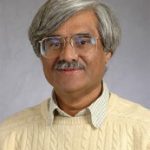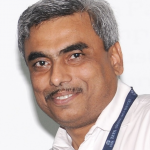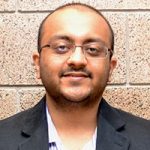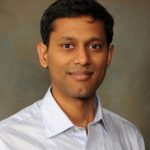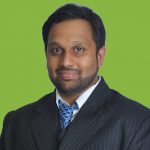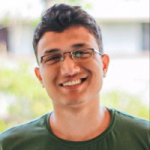Keynote Sessions
Mohan Trivedi is a Distinguished Professor of Electrical and Computer Engineering at University of California San Diego and founding director of the Computer Vision and Robotics Research Laboratory (est. 1986), as well as the Laboratory for Intelligent and Safe Automobiles (LISA) (est. 2001). Trivedi and his team are pursuing research in intelligent vehicles, human-centered autonomous driving, machine perception, machine learning, human-robot interactivity, and advanced driver assistance. LISA research outputs have directly impacted a broad range of commercially deployed ADAS, driver monitoring, active safety, and high autonomy systems, including lane departure warning, lane keep assist, lane/road/vehicle/pedestrian/traffic sign detection/tracking modules, panoramic surround viewing, trajectory prediction and collision avoidance, driver attention, activities, intent and readiness prediction modules. The LISA team has won over 25 “Best/Finalist” paper awards, six best dissertation awards, the IEEE ITS Society’s Outstanding Research Award and LEAD Institution Award, as well as the Meritorious Service and Pioneer Award (Technical Activities) of the IEEE Computer Society. Trivedi has received Distinguished Alumnus awards from BITS-Pilani, India and Utah State University. He has given over 120 keynote/plenary talks. He regularly serves as a consultant to various industry and government agencies in the US and abroad. He frequently serves on panels dealing with technological, strategic, privacy, and ethical issues surrounding research areas he is involved in. Trivedi has served as the Chair of the Robotics Technical Committee of the IEEE Computer Society, Governing Board member of the IEEE Systems, Man & Cybernetics, and IEEE ITSC societies. Trivedi is a Fellow of IEEE, SPIE, and IAPR.
Engineers and scientists engaged in making artificially intelligent systems have successfully resolved many challenging technical problems and have demonstrated the practical viability of autonomous driving on test tracks and carefully selected roads. These are major milestones in engineering and a clear harbinger of a transformative new era of moving goods, supplies, and people from point A to point B. Yet, along with these accomplishments come many new challenges that are not only of a technical nature, but also of a broader social, legal, and even “ethical” nature. Such issues become more urgent and important as collisions and accidents involving self-driving or semi-autonomous vehicles occur more often – injuring and even killing humans in the real world. A key challenge that needs to be addressed is making sure that the artificially engineered automobiles and humans cohabit in a harmonious, safe, and secure manner. For researchers this provides the exciting opportunity to pursue important problems from a broad range of topics in distributed perception, cognition, planning, and control. We will present a “Human-Centered” approach for the development of highly automated vehicle technologies. We will also present a brief sampling of contributions in the development of systems and algorithms to perceive situational criticalities, predict intentions of intelligent agents, and plan/execute actions for safe & smooth maneuvers and control transitions. We will highlight major research milestones in the autonomous vehicles area and discuss issues that require deeper, critical examination and careful resolution to assure safe, reliable, and robust operation of these highly complex systems in the real world.
Marimuthu Palaniswami (Life Fellow, IEEE) is currently a Professor with the Department of Electrical and Electronic Engineering at University of Melbourne, Australia. He received the Ph.D. degree from the University of Newcastle, Callaghan, NSW, Australia. He is an internationally recognized expert in Internet of Things (IoT), Sensor Networks, Automated Learning, and Computational Intelligence in large-scale complex systems. He is a named Distinguished Lecturer of the IEEE Computational Intelligence Society over the period 2013–2015. He has a demonstrated track record in leading large research initiatives. In particular, he is the Founder and Director of the ARC Research Network on Intelligent Sensors, Sensor Networks and Information Processing (ISSNIP), which has become an internationally recognized constellation of researchers, partner universities and industry organisations in the area of sensor networks. He is also a Co-Founder of the European Centred IoT forum. He has authored or coauthored more than 500 scientific papers including books and edited volumes. His research has focused on translational aspects of his research and he has a fantastic track record in working with diverse industry sectors, from defence to environment, from telecom to biomedical and from health to local government domains. He was the General Chair of more than ten IEEE Sponsored International conferences with a focus on Sensor Networks and Internet of Things (IoT).
The only real-time measure we have for investigating fetal wellbeing is the fetal heart rate, which forms specific patterns that indicate healthy or impaired physiological status. Existing ultrasound devices for monitoring the fetal heart rate require continuous sensor adjustment as the baby moves and can only be performed intermittently under clinical supervision. As such, only limited information is known about how markers of fetal wellbeing change outside the hospital environment. We present a smart wearable device capable of continuously monitoring the fetal heart rate throughout pregnancy. This will enable new research into how environmental and maternal factors influence real-time fetal wellbeing.
Recent work by our group has demonstrated that the fetal heart rate can be reliably extracted using a fixed placement of bioelectrical sensors on the maternal abdomen. Using this sensor configuration, we have used deep learning techniques to extract extremely accurate fetal heart rate measurements when compared to traditional signal separation methods. While we shall validate the developed architecture for synthetic and physiological fetal signals, the research outcomes will have applicability across multiple domains for analysing complex multichannel data. The outcomes of the project are due to long standing collaborations with hospitals across multiple countries, clinical teams and private enterprises.
Dr. Arpan Pal is a Distinguished Chief Scientist and Research Area Head, Embedded Devices and Intelligent Systems TCS Research.
Arpan Pal has more than 30 years of experience in the area of Intelligent Sensing, Signal Processing &AI, Edge Computing and Affective Computing. Currently, as Distinguished Chief Scientist and Research Area Head, Embedded Devices and Intelligent Systems, TCS Research, he is working in the areas of Connected Health, Smart Manufacturing, Smart Retail and Remote Sensing.
He is on the editorial board of notable journals like ACM Transactions on Embedded Systems, Springer Nature Journal on Computer Science and is on the TPC of notable conferences like ICASSP and EUSIPCO. He has filed 180+ patents (out of which 95+ granted in different geographies) and has published 160+ papers and book chapters in reputed conferences and journals. He has also written two complete books on IoT and Digital twins in Manufacturing. He is on the governing/review/advisory board of some of the Indian Government organizations like CSIR, MeitY, Educational Institutions like IIT, IIIT and Technology Incubation centres like TIH.
Prior to joining Tata Consultancy Services (TCS), Arpan had worked for DRDO, India as Scientist for Missile Seeker Systems and in Rebeca Technologies as their Head of Real-time Systems. He is a B.Tech and M. Tech from IIT, Kharagpur, India and PhD. from Aalborg University, Denmark.
In this talk Dr. Arpan will introduce Device Edge Computing as one of the means for creating Intelligent Embedded cyber-physical Systems leading towards AI-driven IoT (AIoT). He will discuss some application use-cases of the same in different business domains like Manufacturing, Retail, Healthcare, Oil & Gas, SpaceTech etc. The talk will also introduce some tools and techniques like Signal Processing driven AI, Network Architecture Search, Auto-pruning etc. to convert large-AI models suitable for cloud to Tiny-AI models suitable for frugal, resource constrained edge devices. Finally Dr. Arpan will conclude with introduction to some futuristic technologies in this space, like Neuromorphic Computing, Metamaterials and Nano-sensing Systems.
Invited Talks
Sourabh Bhattacharya is currently an associate professor in the college of engineering at Iowa State University, USA. After finishing his B.tech from IIT, Bombay in 2002, he completed his graduate studies (MS, PhD) in Electrical and Computer Engineering from the University of Illinois at Urbana-Champaign in 2010. His research interests are in game theory, multi-robot systems and cyber-security.
Modern infrastructure systems are complex, interconnected cyber physical system (CPS) that form the lifeline of our society. Recent trends in security indicate the increasing threat of cyber-based attacks, both in numbers and sophistication, on critical infrastructure systems of the world in general. In this talk, I will address resource-constrained attack-defense scenarios on systems modelled as graphs. Specifically, I will consider utility functions that are additive. By leveraging necessary structural properties of Nash equilibria, I will present a characterization of the possible Nash equilibria and demonstrate the existence of a game exhibiting each type. Further, I will present a novel O(m^3) algorithm to compute equilibria based upon our structural analysis where m is the number of assets to be protected. Under the assumption that the defender can perturb the payoffs to the attacker, I will show that the problem of maximizing the expected outcome to the defender is weakly NP-hard in the case of Stackelberg equilibria and multiple attacker resources, and propose a pseudopolynomial time procedure based upon our theory of types to find a globally optimal solution to the problem of maximizing defender expected utility in the case of Nash equilibria under a disjointness assumption. I will conclude my talk with implications of these results for a zero-sum game on a restricted model of the utility function.
Phanindra Tallapragada is an associate professor of mechanical engineering at Clemson University. He obtained his Ph.D in Engineering Mechanics from Virginia Tech in 2010 and did post doctoral research at the University of North Carolina Charlotte. Earlier he obtained his B.Tech and M.Tech in Civil Engineering from the Indian Institute of Technology, Kharagpur. He joined Clemson as an assistant professor in University in 2013. His research interests are in dynamical systems and bioinspired locomotion related to terrestrial motion, fish-like swimming and low Reynolds number swimming.
The immense versatility of animal locomotion made possible by exploiting a variety of physics at different scales suggests that engineered motion barely exploits what is possible. Modeling and intentional design for complex dynamics is important for locomotion of robots in unstructured environments, such as in the offroad environment or on or underwater or for soft and compliant robots with many degrees of freedom. In the case of fish-like swimming I will discuss a novel means of propulsion and maneuvering made possible through purely internal actuators and the role of passive degrees of freedom in improving the agility of a swimmer and enabling hydrodynamic sensing of flow around a swimmer which is otherwise ‘blind’. I will discuss two alternative means for controlling the motion of such a robot. The first involves training a physics informed reinforcement learning agent in steps (a curriculum) to learn a policy to track a path. The second approach uses a linear representation of the dynamics via the Koopman operator. This approach is amenable for linear MPC (but with high dimensions) and I will discuss its use in stabilizing the role of such a nonholonomic robot. Another example of complex dynamics in robots is for off-road ground vehicles where the terramechanics-vehicle interaction can distort sensor data (like camera images) and significantly influence the motion of the vehicle itself. In particular I will talk about the role that suspensions and the heave in determining the vehicle motion using standard half-car or bicycle models with suspensions. I will discuss some preliminary results of stabilizing a model vehicle and path tracking using a Koopman operator approach.
Ashish Cherukuri is an Assistant Professor in Engineering and Technology Institute Groningen, University of Groningen, Netherlands. Previously, he was a Postdoctoral Researcher at the Automatic Control Laboratory, ETH Zurich, Switzerland. He received the B.Tech degree from the Indian Institute of Technology, Delhi, India, in 2008, the M.Sc degree in from ETH, Zurich, Switzerland, in 2010, and the Ph.D. degree in from the University of California, San Diego, CA, USA, in 2017. His research interests include distributed optimization, game theory, optimization under uncertainty with applications in power and transportation networks.
This talk focuses on stochastic optimization problems defined over a network and explores data-driven distributionally robust (DR) solution methods to solve it. Specifically, we will look at chance-constrained optimization that finds application in generation planning problem and expectation minimization problem that is motivated by distributed optimization and federated learning. The DR formulations of the problem have attractive statistical guarantees but pose computational difficulties. The talk will provide algorithms to handle these challenges, paying special attention to the large-scale nature of the problem and the fact that the data about the uncertainty cannot be aggregated at one single location in the network. We will end the talk with future challenges and research directions.
Bamdev Mishra is Principal Applied Scientist at Microsoft India in the Office India Intelligence team. He develops machine learning (ML) solutions for Kaizala, Office Lens, Operations, and Information Protection for Office365, to name a few. Prior to this, he worked on various ML problems in the retail domain including competitive price prediction, review abuse detection, and style recommendations. Bamdev looks into problem domains that allow to use and build ML solutions for industrial applications. On the research side, his primary research interests include nonlinear optimization, stochastic learning, and matrix and tensor learning methods. He has published many technical papers in ML, NLP, and numerical optimization. Bamdev received the BTech and MTech degrees in Electrical Engineering from the Indian Institute of Technology Bombay, India, in 2010, and the Ph.D. degree from the University of Liège, Belgium, in 2014. He was a Postdoctoral Researcher at the University of Liège and a Visiting Research Associate at the University of Cambridge from 2014 to 2015.
Optimal transport or OT has become a relevant tool in various machine learning applications. The rising popularity of OT is because it gives a principled approach in exploiting the underlying metric geometry to develop different notions of distances between probability distributions to be used in downstream applications. Consequently, there have been many works on developing computationally efficient tools to solve OT problems.
In this presentation, we look at the Riemannian approach to solving OT related optimization problems. The Riemannian approach has also become popular for solving structured nonlinear optimization problems. To that end, we discuss some of the recent works on exploiting Riemannian manifold structures to develop optimization-related ingredients for tackling OT formulations. We also look at various challenges and opportunities that lay ahead in making Riemannian tools a viable alternative for OT practitioners.
Dr. Jayashri Vajpai is presently serving as Professor in the Electrical Engineering Department, MBM University, Jodhpur and as Convenor of the Industry Institute Interaction Cell of MBM University. She has also served as the Head of the EE department for a tenure of three years from 2017-20. She is recipient of Sir Thomas Ward Memorial Gold Medal awarded by the Institution of Engineers (I), Kolkata, Eminent Engineering Personality awarded on the occasion of Golden Jubilee of Rajasthan State Centre of IE (I), Jaipur, Dr. Muhammad Harunur Rashid Award for the Best Paper in the 5th International Conference on Renewable Energy Utilization (ICREU-2020), Best Paper Award at NPSC-2008, Utkrashta Seva Samman by JNV University, Jodhpur and Career Award for Young Teachers AICTE, New Delhi. She has also won University Gold Medal and Seth Ram Kunwar Bangur Memorial Gold Medal for BE. She has published over 150 papers in various International and National Journals, Conferences and Seminars.
She is on the Board of Studies of Banasthali Vidyapeeth and JIET, Jodhpur University and has served in the same capacity at Rajasthan Technical University, Kota and CIT, Coimbatore. She is reviewer of several research journals including the prestigious “Nonlinear Dynamics” of Springer, IET Renewable Power Generation and on the editorial board of two International Journals. She is the presenter and subject expert of over 90 educational films on “Artificial Intelligence” being broadcast in the UGC Country-Wide Classroom Programmes. She has delivered invited lectures in a large number of institutions and also rendered services as Guest Faculty in Indian Institute of Technology, Jodhpur. Her research interests include Soft Computing, Artificial Intelligence, Internet of Things, Fault Diagnosis, Adaptive Control, Speech and Image Processing. She has carried out six sponsored research projects in these areas and also guided nine sponsored students’ projects. Ten PhD and over 30 M.E. scholars have worked under her guidance.
She is presently serving as the Executive Member of M.B.M. Engineering College Alumni Association, Jodhpur and has served as the Honorary Secretary and Joint Secretary of the same. She has served as the Executive Member of Institution of Engineers (I) (RSC), Jaipur and as the Executive Member of Institution of Engineers (I) (JLC), Jodhpur. She is the Fellow of Institution of Engineers (India) and Life Member of Indian Society for Technical Education, New Delhi.
Recent developments in computational intelligence, machine learning and soft computing have greatly expanded the horizon of data-driven modelling. However, time series modelling in general and chaotic time series modelling, in particular are still challenging problems of this domain. Soft Computing, which encompasses a plethora of model free approaches ranging from the well- established fuzzy logic to the emerging self-evolving neural networks, has established its credentials in this field of modelling. An attempt will be made in this session to showcase the capabilities of soft computing based models for modelling of chaotic time series and prediction of its future values.
As the name suggests, chaotic time series modelling is based on analysing the data from a system for finding connections between the past values of system state variables (input, internal and output variables) without explicit knowledge of the uncertainties and anomalous phenomena governing the physical behaviour of complex systems. Moreover, such systems often exhibit extreme sensitivity to initial conditions.
Neuro-fuzzy models are capable of self-learning the models of such systems from observed past values of data and identify their underlying interconnections, despite the uncertainty and irregular periodicity deeply ingrained and embedded in the time series data obtained from such systems. These models can be optimised by applying genetic algorithms. Hence, soft computing based hybrid models have been developed by our research group and applied for benchmark and application time series modelling and prediction. Some examples of successful applications will be presented in this session.
Jyotirmoy “Jyo” Deshmukh is an assistant professor in the Department of Computer Science in the Viterbi School of Engineering at the University of Southern California. He directs the CPS-VIDA lab at USC. Prior to joining USC, Jyo was a Principal Research Engineer at Toyota R&D. He received his PhD from the University of Texas at Austin. He is the recipient of the 2021 NSF Career Award and the 2021 Amazon Faculty Research Award. His research focuses on the verification, testing, design, and analysis of cyber-physical systems, especially those containing machine learning and AI-based components, time-series analysis for sequential data, trustworthiness in multi-agent systems, and specification formalisms.
Computing is undergoing a paradigm shift: treating programs as mechanical procedures that realize a mathematical specification is slowly being replaced by a host of statistical learning methods that exploit the power of data abundance, preternatural generalization abilities, and efficient hardware platforms. While this is perhaps an acceptable approach for programs that decide what new product to suggest to a potential customer, it is potentially a recipe for disasters when applied to the paradigm of safety-critical systems. The question this talk seeks to answer is: why can we not have the best of both worlds? Can we combine learning techniques (for example reinforcement learning (RL) and deep RL) with traditional techniques for the design of safety-critical systems? We will look at some recent work where we are able to perform reward shaping from high-level temporal logic specifications such that any off-the-shelf RL algorithm that maximizes the expected long-term returns is guaranteed to maximize the probability of satisfying a given temporal logic specification. This result lets us not worry about good hand-crafted rewards that guarantee desired and safe behaviour, but instead uses mathematically precise high-level specifications to automatically infer such rewards. We will also examine how logical specifications can be leveraged to drastically reduce the number of demonstrations required to learn control policies from user demonstrations. Again, the objective is to move away from inferring implied task objectives (and control policies) from expert demonstrations to using temporal logic to formally specify high-level task objectives and couple it with non-expert demonstrations to infer optimal control policies. The main agenda of this talk is to argue for a logic-based framework to provide formal safety arguments for autonomous systems without sacrificing the advances provided by learning.
Sagar Pathrudkar and Saadhana Venkataraman work as Lead Research Engineers in the Autonomous Systems and Control Research Group at Siemens Technology India. The Autonomous System group in India works towards transforming state-of-the-art research into robust, ready-to-productize solutions in the general area of Autonomous Systems with an initial focus on Autonomous Vehicles. The group works on translational technology topics such as Large Scale AV Data Management, Scenario Search, Multi-Sensor Perception, Data Driven Behavior Modelling, Real2Sim Scenario Generation and Safety and Risk Analysis of Autonomous Vehicles to help Siemens Business Units accelerate the deployment of products and solutions in the AV space.
One of the major impediments in the deployment of Autonomous Driving Systems (ADS) is their safety and reliability. The primary reason for the complexity of testing ADS is that it operates in an open world characterized by its non-deterministic, high-dimensional and non-stationary nature where the actions of other actors in the system are uncontrollable from the ADS perspective. This is a state space explosion problem and one way of mitigating this is by concretizing the scope for the system under test (SUT) by testing only for a set of behavioral competencies which an ADS must demonstrate. A popular approach to testing ADS is scenario-based testing where the ADS driving stack is presented with driving scenarios from the real world (and synthetically generated) data and expected to meet defined safety criteria while navigating through the scenario.
We present SAFR-AV, an end-to-end ADS validation platform to enable scenario-based ADS testing in a data-driven manner. Our work addresses key real-world challenges of a) building an efficient large scale data ingestion and search engine to identify scenarios of interest from real world data, b) creating digital twins of the real-world scenarios to enable SIL testing in ADS simulators and, c) identifying key scenario parameter distributions to enable optimization of scenario coverage. These modules along with others such as Coverage Optimizer, Intelligent Sampler and Safety Analyzer would allow the SAFR-AV platform to provide ADS pre-certifications.
Mukunda received his Master's Degree and PhD from Delft University of Technology, The Netherlands. His PhD research focused on effectively combining supervised learning and optimal control for sampling-based motion planning. His work experience includes developing modular robotic solutions with ROS, Tooling software infrastructure for Smart Home technology and automotive software. He currently leads the robotics software team at ARTPARK and works on projects related to network-enabled automation and tele-presence solutions with mobile robots. He is also affiliated with the Robert Bosch Centre for Cyber Physical Systems, Indian Institute of Science, Bengaluru, as a guest faculty.
Human - Robot co-existence and collaboration in warehouse automation ecosystems has enabled the creation of intelligent solutions by combining human adaptivity with robotic efficiency. With a growing demand for higher warehouse throughput owing to the ever expanding e-commerce industry, expediting robot operations is becoming increasingly necessary. However, such a change in operational paradigm imposes very strict requirements on the safety of humans and other robots in a warehouse. Recent advances in low latency, high performance network infrastructure such as 5G/WiFi6 present a great opportunity to create mobile automation solutions with safety guarantees by leveraging the awareness via network. In other words, such a high quality network infrastructure opens up an additional layer of perception that is not strictly limited to on-board sensors on a robot such as lidars and cameras.This talk focuses on a few recent activities at ARTPARK-IISc that showcase the benefits of augmenting on-board sensing on robots with network-awareness. Specifically, the focus will be on a few applications such as proactive collision detection and avoidance in multi-robot systems, safety behaviors around humans and a co-simulation framework for robots and networks.
Tutorial Sessions
Aranya Chakrabortty received his PhD degree from Rensselaer Polytechnic Institute, Troy, New York, in 2008 in electrical engineering. From 2008 to 2009, he was a postdoctoral research associate at the University of Washington, Seattle. From 2009 to 2010, he was an assistant professor of electrical and computer engineering at Texas Tech University, in Lubbock. Since 2010, he has been a faculty member of the Electrical and Computer Engineering Department at North Carolina State University, Raleigh, where he is currently an associate professor, a university faculty scholar, and also affiliated to the NSF FREEDM Systems Center. His research interests are in all branches of control theory with applications to electric power systems, and more recently in exploring new research topics at the intersection of control and reinforcement learning. He has served as an editor for the IEEE Transactions on Power Systems and the IEEE Transactions on Control System Technology. He received the NSF CAREER Award in 2011. In 2019 he was named as a faculty scholar by the NC State Provost's office.
Reinforcement Learning (RL) is an effective way of designing model-free linear quadratic regulator (LQR) controllers for linear time-invariant (LTI) networks with unknown state-space models. However, when the network size is exceptionally large as in many practical systems such as electric power grids or transportation networks, conventional RL can result in unacceptably long learning times, making it impossible to control the network in real-time. In this tutorial, I will present three new designs, each with its own distinct formulation and control method, that resolve this problem by combining three different variants of dimensionality reduction with RL theory:
(1) The first design will consider the case when the network model exhibits a time-scale separation in its dynamics. Singular perturbation theory will be used for the dimensionality reduction and approximation of the RL controller, followed by stability proofs and sub optimality analysis.
(2) The second design will consider the case when the network model does not exhibit any time-scale separation, but its controllability gramian exhibits a low rank property implying redundancy of the control input. A method for compressing the state vector and designing a RL controller with this compressed state will be developed.
(3) The third design will consider the case when neither the network model has time-scale separation nor does the control input have any redundancy, but the control objective is separated into multiple sub-objectives. A nested RL controller will be developed by leveraging parallelization of local controllers with dimensionality reduction of a global controller.
For all three designs, parallels will be drawn from wide-area oscillation damping control of electric power system networks. Validation examples will be shown for RL-based wide-area control of the IEEE prototype power system models. The tutorial will end with a list of promising future research directions for model-free control of power grids with renewables.
Sourabh Bhattacharya is currently an associate professor in the college of engineering at Iowa State University, USA. After finishing his B.tech from IIT, Bombay in 2002, he completed his graduate studies (MS, PhD) in Electrical and Computer Engineering from the University of Illinois at Urbana-Champaign in 2010. His research interests are in game theory, multi-robot systems and cyber-security.
In the last decade, there has been extensive deployment of robots in agricultural fields for various applications. In this presentation, I am going to specifically talk about a mobile sensor network developed in my lab for soybean phenotyping. I will talk about planning and estimation problems that arise in deployment of the mobile sensor network. Next, I will present a novel UAV-UGV system developed in my lab for battery refuelling. Finally, I will present planning and scheduling problems that arise in deployment of the field-robotic system for long-term autonomy.
